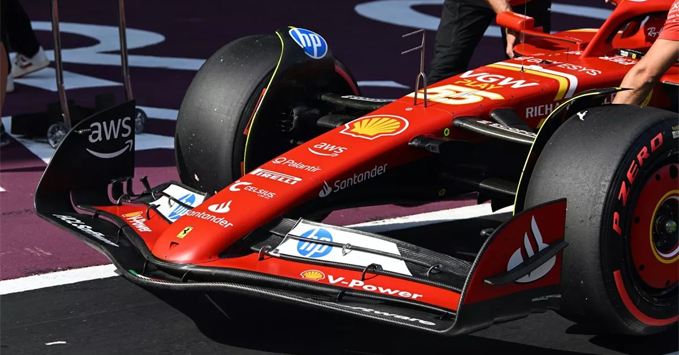Ferrari rejects wing flexing and works to stabilize SF-24 ahead of United States GP

Yesterday at 02:21 PM
In Formula 1, there has been a lot of talk about flexible wings. It has even been said that Ferrari would adapt in this regard, creating specific wing designs that could show greater flexibility. McLaren produced a rear wing that "wasn't well received" by competitors to say the least and, by their own admission, after a conversation with the International Federation, during the Singapore Grand Prix weekend decided not to use it anymore. Lando Norris stated that the supposed advantage was not as significant as the competition had estimated, since the version used for the last time at the Baku city circuit in the Azerbaijan Grand Prix was not able to deliver the performance boost highlighted by rivals.
Beyond this controversy, there is an interesting issue that must be emphasized, and it doesn’t only concern the rear of the car. Current Formula 1 cars are highly dependent on the perfect use of the floor in order to achieve adequate performance. Therefore, it is essential to stabilize the aerodynamic platform to give drivers the ability to improve handling and, consequently, access the maximum performance of the car on every type of racing track. Several teams have struggled with this problem, including Ferrari, Mercedes, and Red Bull, speaking only of the top teams.
The Milton Keynes team is working hard to fix this issue, which stems from a floor that cannot manage the height variations from the ground at different speeds. At the 5.513-kilometre Circuit of The Americas in Austin, Texas, there will be updates to correct this situation. A substantial aerodynamic upgrade package is expected for the Austrian side, which, according to Helmut Marko, will make a significant improvement for the RB20. Red Bull team principal Christian Horner shares this view and is eagerly awaiting the United States Grand Prix weekend in Austin to assess the work done by the technical department, now led by French engineer Pierre Waché.
Mercedes will also arrive at round 19 of the 2024 Formula 1 championship with several new developments. Like Red Bull, the main goal is to enhance the performance of the German car. In the specific case of the W15, engineers, led by former Ferrari engineer James Allison, have worked to ensure a better transition between high and low-speed corners. The Brackley team has found a lot of competitiveness when they have been able to manage this important factor, a key element that provided them with a lot of success during the summer months, where, unsurprisingly, they secured three victories in just a few weeks.
On the other hand, the Maranello team recently introduced a new version of the front wing as part of various updates. This is a genuine upgrade, not just an adaptation for the Marina Bay streets circuit. It features increased angle of the elements closest to the nose, the area responsible for providing the most downforce, while the outer portion has been relieved to enhance the outwash effect. Overall, the Maranello team’s efforts have been focused on disciplining the airflow directed toward the entrance of the floor, which is the first component that directs the fluid mass impacting the car.
Observing the aeroelasticity of this specific component during the Singapore Grand Prix, we did not notice a different degree of flexing compared to the recent past. As we know, when speeds increase in high-speed sections, considering the force applied to the front wing, its initial position (with the car stationary) changes and reduces drag. It does this through a slight rotation of part of the element on the fixed portion, creating a benefit by lowering the car's drag.
Clearly, such a practice is regulated by the International Federation’s technical regulations. We are referring to the static tests and those that the FIA performs on the moving vehicle using sensors installed on the wings of the cars. At this point, a clarification is needed. To achieve greater flexibility in the component, during the production of the element, technicians orient the carbon fibers perpendicularly to the direction of the force applied. Understanding precisely if some teams have been more successful in this practice is not easy.
Ferrari has not adapted to the supposed greater flexing seen in other teams like McLaren and Mercedes, and for now, nothing new can be confirmed on this front. Rather, when discussing the Italian side, it is more interesting to emphasize the effect that the new front wing could have on the SF-24. We return to the initial topic, related to the car's balance on both axles. At the Marina Bay street circuit, we saw a Ferrari that was fairly precise in this regard, indicating that the downforce produced by the Italian car was balanced on both axes of the car.
And this is precisely what Ferrari desires, having changed the development direction to optimize the SF-24 car's performance since the ill-fated floor update introduced by the Maranello technicians at the Circuit de Catalunya in Barcelona. Austin will provide further answers, as it is still unclear whether the update presented at the last round of the 2024 Formula 1 season delivered the expected results. The layout of the Circuit of The Americas is very demanding in terms of compromise, and the answers Ferrari is waiting for will be very useful for the short-term future, where the Maranello team is laying the foundations for 677 project, the single-seater for the 2025 F1 championship.
The post Ferrari rejects wing flexing and works to stabilize SF-24 ahead of United States GP appeared first on Scuderia Fans.


